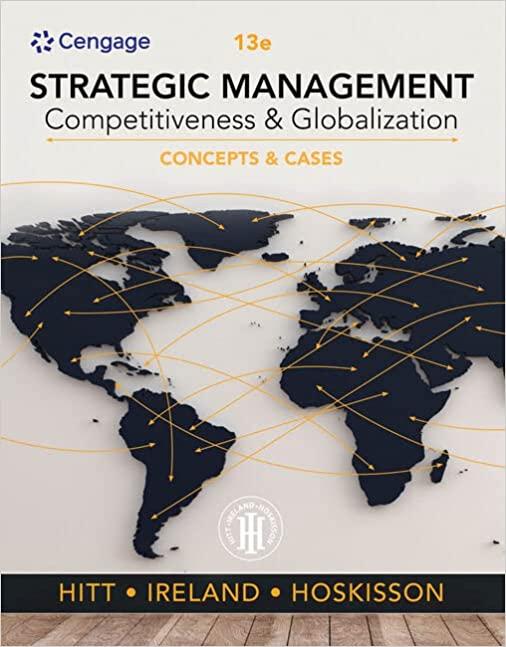Question
Give your take on the following posts. Do you agree or disagree with what was said in each posts? Post 1 The choice of modeling
Give your take on the following posts. Do you agree or disagree with what was said in each posts?
Post 1
The choice of modeling type for analyzing internal and external organizational environments, risks, and uncertainties depends on the specific objectives and context of the organization. Each model offers distinct advantages and is suited to different strategic decision-making scenarios.
Porter's Five-Forces Model provides a comprehensive framework for assessing the competitive dynamics of an industry. This model is particularly effective for understanding external forces such as industry rivalry, supplier and buyer power, threats of new entrants, and substitutes. It helps organizations identify key market trends, potential threats, and opportunities. When an organization aims to formulate strategies that consider the broader competitive landscape and market conditions, Porter's Five-Forces Model is a valuable choice (Porter, 1979).
Internal and External Factor Evaluation Matrices (IFE and EFE matrices) are useful when organizations need to evaluate both internal strengths and weaknesses, as well as external opportunities and threats. These matrices assist in objectively weighing factors and prioritizing them based on their significance. IFE focuses on internal factors, while EFE emphasizes external factors. This approach is suitable when organizations seek to align their resources with strategic priorities and anticipate potential challenges (David, 2019).
The Competitive Profile Matrix (CPM) facilitates a comparative analysis of an organization's strengths and weaknesses against its competitors. This model helps identify areas where an organization has a competitive advantage and areas that require improvement. When the focus is on benchmarking against industry peers and understanding the organization's relative market position, CPM is a valuable tool (Wheelen & Hunger, 2011).
In conclusion, the selection of the most appropriate modeling type depends on the specific needs of the organization. If the aim is to analyze the external competitive landscape, Porter's Five-Forces Model is ideal. For a holistic evaluation of internal and external factors, Internal and External Factor Evaluation Matrices are suitable. When the focus is on comparative analysis against competitors, the Competitive Profile Matrix is the preferred option. Effective decision-making involves considering the organization's goals, available data, and the level of insight required to navigate risks and uncertainties successfully.
Post 2
The best modeling type depends on your specific goals and the aspects you want to address in your strategic analysis.
The Porter Five Forces model focuses on analyzing the competitive environment of an industry. It considers five key forces: Rivalry among competing firms, Potential entry of new competitors, Potential development of substitute products, and Bargaining power of suppliers. It helps organizations understand the dynamics of their industry, identify potential risks, and develop strategies to enhance their competitive position. It's particularly useful when you're looking to assess the external factors that impact your organization's industry and competitive landscape.
Internal and External Factor Evaluation Matrices (IFE and EFE) are tools used to evaluate an organization's internal and external environment, and to reveal its strengths and weaknesses (Jurevicius, 2022). The IFE matrix identifies an organization's internal strengths and weaknesses while the EFE matrix identifies opportunities and threats in the external environment which is important when you want to build strategies that leverage your strengths and address your weaknesses while capitalizing on opportunities and mitigating threats.
The Competitive Profile Matrix (CPM) identifies a firm's major competitors and its strengths and weaknesses in relation to a sample firm's strategic position (Jurevicius, 2022). It is an essential strategic management tool that helps businesses identify their competitive advantages and disadvantages relative to their competitors. The CPM is valuable when you want to have a clear understanding of how your organization stands in comparison to its rivals, enabling you to strategize accordingly.
In summary, all models are available for evaluating internal and external environments. However, if you are focusing on industry competition, Porter's Five Forces Model could be the best fit. If you are looking for a comprehensive view of your internal and external factors, the combination of IFE and EFE matrices might be suitable and if you are more interested in direct competitor comparison, the Competitive Profile Matrix might be the right choice. Often, a combination of these models can provide a well-rounded analysis of your organization's strategic landscape.
Step by Step Solution
There are 3 Steps involved in it
Step: 1

Get Instant Access to Expert-Tailored Solutions
See step-by-step solutions with expert insights and AI powered tools for academic success
Step: 2

Step: 3

Ace Your Homework with AI
Get the answers you need in no time with our AI-driven, step-by-step assistance
Get Started


